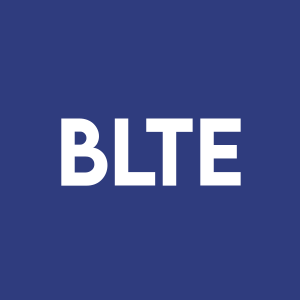Belite Bio Announces First Patient Dosed in Phase 2/3 DRAGON II Trial of Tinlarebant for the Treatment of Stargardt Disease
Rhea-AI Summary
Belite Bio (NASDAQ: BLTE) has dosed the first patient in the Phase 2/3 DRAGON II trial of Tinlarebant for Stargardt Disease (STGD1) treatment. The trial will evaluate the efficacy, safety, and tolerability of Tinlarebant in about 60 adolescent STGD1 subjects across the U.S., U.K., and Japan. Tinlarebant, an oral therapy designed to reduce vitamin A-based toxin accumulation causing retinal disease, has received Orphan Drug and Sakigake Designation in Japan. The trial follows a completed Phase 1b study in Japan and is part of Belite's efforts to address unmet needs in STGD1 treatment. Simultaneously, Belite's Phase 3 PHOENIX trial for Tinlarebant in Geographic Atrophy (GA) is ongoing with over 200 subjects enrolled.
Positive
- First patient dosed in Phase 2/3 DRAGON II trial for Tinlarebant in STGD1 treatment
- Tinlarebant granted Orphan Drug and Sakigake Designation in Japan for STGD1 treatment
- Phase 1b of DRAGON II trial completed in Japan
- Over 200 subjects enrolled in ongoing Phase 3 PHOENIX trial for Tinlarebant in GA
Negative
- None.
News Market Reaction 1 Alert
On the day this news was published, BLTE gained 0.06%, reflecting a mild positive market reaction.
Data tracked by StockTitan Argus on the day of publication.
- Phase 2/3 of the DRAGON II trial will evaluate the efficacy, safety, and tolerability of Tinlarebant in approximately 60 adolescent STGD1 subjects across the U.S., U.K., and Japan
- Phase 1b of DRAGON II trial to evaluate pharmacokinetics and pharmacodynamics of Tinlarebant in Japanese subjects was recently completed
- Tinlarebant granted Orphan Drug and Sakigake (Pioneer Drug) Designation in Japan for the treatment of STGD1
- Pivotal global Phase 3 trial of Tinlarebant in GA subjects (“PHOENIX”) is ongoing and more than 200 subjects have been enrolled
SAN DIEGO, Sept. 10, 2024 (GLOBE NEWSWIRE) -- Belite Bio, Inc (NASDAQ: BLTE) (“Belite” or the “Company”), a clinical-stage biopharmaceutical drug development company focused on advancing novel therapeutics targeting degenerative retinal diseases that have significant unmet medical needs, today announced that the first patient has been dosed at the Tokyo Medical Center in the Phase 2/3 portion of its DRAGON II clinical trial evaluating Tinlarebant for the treatment of STGD1. Tinlarebant is a novel oral therapy designed to reduce the accumulation of vitamin A based toxins that cause retinal disease, and this Phase 2/3 study will evaluate the efficacy, safety, and tolerability of Tinlarebant in approximately 60 adolescent STGD1 subjects across the U.S., U.K., and Japan.
“We are pleased to have successfully dosed the first subject in the Phase 2/3 portion of our DRAGON II trial. This milestone is a significant step forward in our mission to address the unmet needs of people living with Stargardt Disease,” said Dr. Tom Lin, Chairman and CEO of Belite Bio. “We recently completed a Phase 1b study of Tinlarebant in STGD1 patients at the Tokyo Medical Center and are happy to be continuing to partner with them for this next trial. With enrollment now also underway at sites in the U.S. and U.K., we are making meaningful progress toward our goal of delivering a life-changing oral therapy to those affected by this condition.”
“DRAGON II is the first global Stargardt disease trial in Japan. As such, it provides the unprecedented opportunity for Japanese patients and their families to gain access to a potential therapy for this historically untreatable disease,” added Professor Kaoru Fujinami, Principal Investigator at National Hospital Organization, Tokyo Medical Center. “The level of interest we have received in this trial speaks to the urgency of the unmet need for patients living with STGD1. Following Tinlarebant’s receipt of Sakigake designation from Japan’s Ministry of Health, we feel well positioned to rapidly advance this trial and are working diligently to get this much needed therapy to patients.”
The DRAGON II trial is a combination of Phase 1b open-label study in Japan to evaluate the pharmacokinetics (PK) and pharmacodynamics (PD) of Tinlarebant, administered daily for 7 days in Japanese adolescent STGD1 subjects and a Phase 2/3, multicenter (U.S., U.K., and Japan), double-masked, placebo-controlled, randomized study designed to evaluate the efficacy, safety, and tolerability of Tinlarebant, administered daily for 24 months in adolescent STGD1 subjects. Approximately 60 subjects, aged 12 to 20 years old, including approximately 10 Japanese subjects, are targeted for enrollment in the Phase 2/3 portion of the trial with a 1:1 randomization (Tinlarebant:placebo). The data from the Japanese subjects is intended to facilitate future NDA applications in Japan.
About Tinlarebant (a/k/a LBS-008)
Tinlarebant is a novel oral therapy that is intended to reduce the accumulation of vitamin A-based toxins (known as bisretinoids) that cause retinal disease in STGD1 and also contribute to disease progression in GA, or advanced Dry AMD. Bisretinoids are by-products of the visual cycle, which is dependent on the supply of vitamin A (retinol) to the eye. Tinlarebant works by reducing and maintaining levels of serum retinol binding protein 4 (RBP4), the sole carrier protein for retinol transport from the liver to the eye. By modulating the amount of retinol entering the eye, Tinlarebant reduces the formation of bisretinoids. Tinlarebant has been granted Fast Track Designation and Rare Pediatric Disease designation in the U.S., Orphan Drug Designation in the U.S. Europe, and Japan, and Sakigake Designation in Japan for the treatment of STGD1.
Stargardt Disease (STGD1)
STGD1 is the most common inherited retinal dystrophy (causing blurring or loss of central vision) in both adults and children. The disease is caused by mutations in a retina-specific gene (ABCA4), which results in progressive accumulation of bisretinoids leading to retinal cell death and progressive loss of central vision. The fluorescent properties of bisretinoids and the development of retinal imaging systems have helped ophthalmologists identify and monitor disease progression. Currently, there are no FDA approved treatments for STGD1.
Importantly, STGD1 and GA, or advanced Dry AMD, share a similar pathophysiology, which is characterized by the excessive accumulation of bisretinoids, retinal cell death, and progressive loss of vision. Vision loss occurs slowly, despite peripheral expansion of “dead retina,” until the disease reaches the center of the eye (the macula). Therefore, Belite Bio is evaluating safety and efficacy of Tinlarebant in GA patients in a 2-year Phase 3 study (PHOENIX).
About Belite Bio
Belite Bio is a clinical-stage biopharmaceutical drug development company focused on advancing novel therapeutics targeting degenerative retinal diseases that have significant unmet medical needs, such as Stargardt Disease type 1 (STGD1) and Geographic Atrophy (GA) in advanced dry age-related macular degeneration (AMD), in addition to specific metabolic diseases. Belite’s lead candidate, Tinlarebant, an oral therapy intended to reduce the accumulation of toxins in the eye, is currently being evaluated in a Phase 3 study (DRAGON) and a Phase 2/3 study (DRAGON II) in adolescent STGD1 subjects and a Phase 3 study (PHOENIX) in subjects with GA. For more information, follow us on Twitter, Instagram, LinkedIn, Facebook or visit us at www.belitebio.com.
Important Cautions Regarding Forward Looking Statements
This press release contains forward-looking statements about future expectations and plans, as well as other statements regarding matters that are not historical facts. These statements include but are not limited to statements regarding the potential implications of clinical data for patients, and Belite Bio’s advancement of, and anticipated preclinical activities, clinical development, regulatory milestones, and commercialization of its product candidates, and any other statements containing the words “expect”, “hope” and similar expressions. Actual results may differ materially from those indicated in the forward-looking statements as a result of various important factors, including but not limited to Belite Bio’s ability to demonstrate the safety and efficacy of its drug candidates; the clinical results for its drug candidates, which may not support further development or regulatory approval; the timing to complete relevant clinical trials and/or to receive the interim/final data of such clinical trials; the content and timing of decisions made by the relevant regulatory authorities regarding regulatory approval of Belite Bio’s drug candidates; the potential efficacy of Tinlarebant, as well as those risks more fully discussed in the “Risk Factors” section in Belite Bio’s filings with the U.S. Securities and Exchange Commission. All forward-looking statements are based on information currently available to Belite Bio, and Belite Bio undertakes no obligation to publicly update or revise any forward-looking statements, whether as a result of new information, future events or otherwise, except as may be required by law.
Media and Investor Relations Contact:
Jennifer Wu / ir@belitebio.com
Julie Fallon / belite@argotpartners.com








